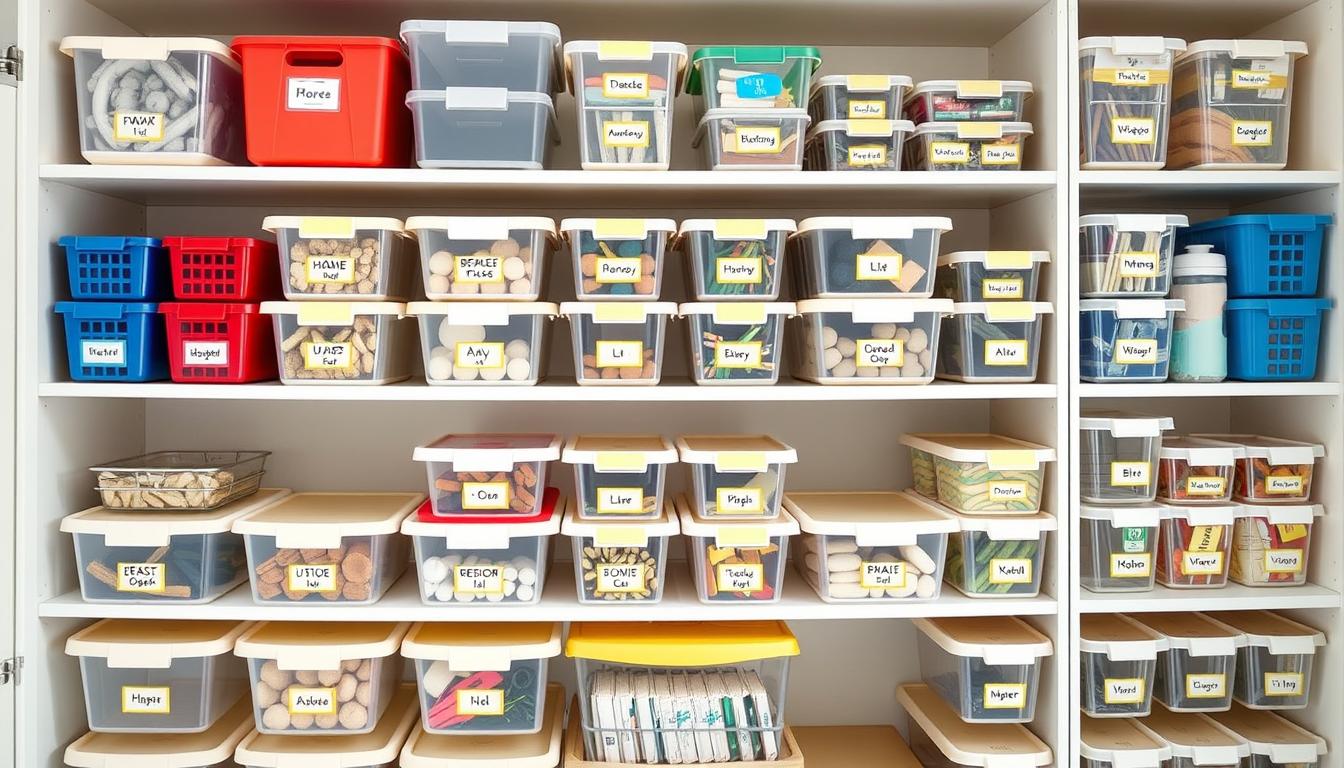In today’s fast-paced world, creating an organized system is vital. Labeling systems are key to achieving this. They help streamline storage and make items easily accessible. This saves time and reduces stress, making a good labeling system an essential investment.
Labeling systems and organization methods are crucial for a clutter-free space. With the right tools, individuals can create a system that suits their needs. Whether for personal or professional use, a well-organized system boosts productivity and satisfaction.
Key Takeaways
- Investing in a good labeling system can save time and reduce stress
- Effective organization methods are crucial in maintaining a clutter-free environment
- Labeling systems and organization methods can increase productivity and overall satisfaction
- A well-organized system can make a significant difference in personal and professional settings
- Streamlining storage through labeling systems can ensure easy access to items
- Implementing a labeling system can be beneficial for individuals and businesses alike
Understanding the Power of Effective Storage Labels
Effective storage labels are the cornerstone of any organized setup, making it easy to spot and access stored items. By employing storage markers and label makers, one can craft a labeling system that meets their exact needs. This approach boosts productivity and minimizes waste, as items are clearly marked and easy to find.
Storage markers and label makers offer customization options, enabling users to design labels that are both informative and straightforward. Proper labeling is key to keeping spaces tidy, as it helps individuals swiftly identify items and make informed decisions about their use or disposal.
Why Proper Labeling Matters
Proper labeling is vital for a well-organized storage system, as it makes it simple to find and access items. This simplicity leads to greater efficiency and less waste, as items are clearly marked and easy to locate. The benefits of proper labeling include:
- Increased efficiency, as items are easily locatable
- Reduced waste, as items are less likely to be misplaced or forgotten
- Improved safety, as hazardous materials are clearly labeled and identifiable
The Psychology of Organization
The psychology of organization is intricate, with various factors influencing one’s ability to keep spaces tidy. Yet, by using storage markers and label makers, individuals can tailor a labeling system that fits their needs. This leads to a more organized and productive environment.
Cost Benefits of Organized Storage
Organized storage significantly impacts one’s financial well-being, as it enables quick identification and access to items, reducing waste and boosting productivity. By employing storage markers and label makers, one can create a system that is both organized and cost-effective.
| Benefits of Organized Storage | Description |
|---|---|
| Increased Productivity | Quickly identify and locate stored items, reducing time spent searching for materials |
| Reduced Waste | Clearly label and identify stored items, reducing the likelihood of misplacement or disposal |
| Improved Safety | Clearly label hazardous materials, reducing the risk of accidents or injuries |
Types of Storage Labels for Different Environments
Inventory systems are vital for managing storage, ensuring items are tracked and accounted for. Various settings, like homes, offices, and warehouses, demand specific storage labels. For example, warehouses need labels that can handle harsh conditions, while homes require labels that are clear and simple to read.
In offices, labels help identify files, documents, and other critical materials. Inventory systems can be linked with these labels to monitor item locations and statuses. This enhances productivity and minimizes the chance of lost or misplaced documents.
- Barcode labels, which can be used to track inventory and manage stock levels
- Color-coded labels, which can be used to categorize and prioritize items
- Weather-resistant labels, which can be used in outdoor or harsh environments
These labels serve a wide range of environments, from homes and offices to warehouses and distribution centers. Selecting the appropriate storage label can significantly enhance inventory systems and lower the risk of errors or losses.
Choosing the Right Label Materials for Durability
The materials used for labels are key in creating a reliable storage system. Durable labels can handle different environmental conditions, keeping storage contents organized and easy to identify. It’s crucial to pick the right label materials, looking at weather resistance, temperature tolerance, and chemical resistance. Using the right organization tools, like label holders and dispensers, boosts the durability of storage labels.
Some key considerations for label materials include:
- Weather-resistant options, such as waterproof or UV-resistant labels, to protect against outdoor or harsh indoor conditions
- Temperature-tolerant materials, capable of withstanding extreme temperatures, to ensure label longevity in various environments
- Chemical-resistant solutions, designed to resist damage from chemicals or cleaning products, to maintain label integrity in industrial or laboratory settings
Choosing the right label materials and using effective organization tools helps create a strong storage system. This streamlines workflow and reduces errors. It leads to higher productivity and efficiency, making it vital for any organization’s operations.
Essential Tools for Creating Professional Storage Labels
Creating professional storage labels requires the right tools. Storage tracking is key to inventory management. You’ll need a label maker, a computer with design software, and a printer.
A label maker is essential for quick and easy label printing. There are many types, from handheld to desktop printers. The DYMO LabelWriter is a favorite among businesses and individuals.
You also need label design software. This lets you add your company’s logo, text, and images to labels. Avery Design & Print and LabelWorks are top choices. They offer templates and tools for professional labels.
Here are the must-have tools for professional storage labels:
- Label maker
- Label design software
- Printer
- Labels and ribbons
Investing in these tools ensures high-quality labels. They help keep you organized and streamline storage tracking.
With the right tools and software, you can tailor labels to your needs. This improves inventory management efficiency.
| Tool | Description |
|---|---|
| Label Maker | A device that prints labels quickly and easily |
| Label Design Software | A program that allows you to create custom labels with your company’s logo, text, and images |
| Printer | A device that prints labels and other documents |
Design Principles for Effective Storage Labels
Creating effective storage labels involves several key design principles. A well-designed label can significantly enhance your storage system’s organization, efficiency, and ease of use. Tailoring labeling systems to specific needs is essential, and understanding the various design options is crucial.
Effective storage labels must be clear, concise, and simple to read. Achieving this can be done through the use of color coding systems, appropriate font selection, and adherence to size and placement guidelines. For example, employing different colors to categorize items can facilitate quick identification of what’s stored in a container. Font selection is also critical, as it should be legible from a distance.
Key considerations for designing effective storage labels include:
- Using a clear and concise font
- Selecting a font size that is easy to read from a distance
- Utilizing color coding systems to categorize items
- Ensuring that labels are placed in a visible and accessible location
By integrating these design principles into your labeling systems, you can establish a storage system that is both efficient and organized.
| Design Principle | Importance |
|---|---|
| Color Coding Systems | High |
| Font Selection | Medium |
| Size and Placement Guidelines | High |
Implementing a Comprehensive Labeling System
Implementing a comprehensive labeling system is crucial, and organization methods are key. By categorizing and prioritizing items, one can ensure an effective labeling system. This requires a structured labeling approach, tailored to the specific needs of the space or items.
To achieve this, consider the following steps:
- Assess the space or items to be labeled, identifying categories and priorities
- Develop a labeling system that is consistent and easy to understand
- Use clear and concise language on labels, avoiding ambiguity
By following these steps and incorporating organization methods into the labeling process, individuals can create a comprehensive labeling system. This system is tailored to their specific needs. It leads to increased efficiency, reduced errors, and improved overall organization.
As part of a comprehensive labeling system, consider using visual aids like images to help illustrate the process.
By taking a structured approach to labeling and incorporating organization methods, individuals can create a system that is both effective and efficient. This leads to a more organized and productive environment.
Digital Integration: Smart Storage Labels and Tracking
Digital integration is crucial in modern storage solutions, enhancing our labeling systems. It combines the use of storage markers and label makers for better organization. This integration enables us to track and manage our storage efficiently, making it a key part of any system.
QR code integration, inventory management apps, and cloud-based tracking systems are at the forefront of digital integration. These tools simplify accessing information about stored items, streamlining management. By merging physical labels with digital tools, we achieve a comprehensive system that boosts efficiency and effectiveness.
QR Code Integration
QR code integration links physical labels to digital data. This includes item descriptions, storage locations, and expiration dates. It allows for quick access to this information, simplifying storage management.
Inventory Management Apps
Inventory management apps are vital for digital integration. They help track and manage stored items, ensuring accurate storage records. These apps reduce errors and misplacement, keeping storage up-to-date.
Cloud-Based Tracking Systems
Cloud-based tracking systems are essential for digital integration. They enable tracking and management from anywhere, at any time. This ensures storage security and accessibility, facilitating easier management.
Integrating digital tools into our storage solutions creates a smart, efficient labeling system. With storage markers, label makers, and digital tools, we elevate our organization. Our storage remains accurate and up-to-date, thanks to these advancements.
| Tool | Description |
|---|---|
| QR Code Integration | Links physical storage labels to digital information |
| Inventory Management Apps | Tracks and manages stored items |
| Cloud-Based Tracking Systems | Tracks and manages stored items from anywhere |
Maintenance and Updates: Keeping Your System Current
To ensure your storage labeling system lasts and works well, regular maintenance and updates are key. Inventory systems are vital in this effort, tracking your items and their labels. A strong inventory system makes it easy to spot and update labels that are outdated or incorrect.
Regular audits are crucial for keeping your labeling system current. These audits can be done manually or with automated tools, depending on your storage facility’s size and complexity. Important aspects to check during audits include:
- Label accuracy and consistency
- Item quantity and location
- Label durability and condition
By updating your labeling system regularly and using inventory systems in your maintenance routine, your storage facility will stay organized and efficient. This leads to better productivity, fewer mistakes, and enhanced performance overall.
Common Mistakes to Avoid in Storage Labeling
Storage labeling mistakes can hinder efficiency and cause disorganization. Understanding the importance of proper labeling is crucial. Organization tools play a significant role in maintaining an organized storage system.
Choosing the wrong materials for labels is a common error. Low-quality labels or materials not suited for the environment can deteriorate or become unreadable. Using tools like label holders and dispensers can protect labels and keep them legible.
Poor Material Selection
Another mistake is inconsistent naming conventions. Different names for similar items can cause confusion and make finding specific items challenging. Establishing a consistent naming system and using tools to ensure label uniformity is essential.
Inconsistent Naming Conventions
Size and visibility issues are also common. Labels that are too small or not easily seen can be hard to read. It’s important to use large, visible labels and tools like label magnifiers or LED lights to enhance readability.
Inadequate Size and Visibility
Avoiding these mistakes and effectively using organization tools can create an efficient storage system. Tools such as label holders, magnifiers, and LED lights are beneficial. They help prevent common errors and ensure a well-organized environment.
- Label holders and dispensers
- Label magnifiers or LED lights
- Label software and printers
By employing these tools and avoiding common pitfalls, individuals and businesses can develop a tailored storage labeling system. This system enhances efficiency and productivity.
| Organization Tool | Description |
|---|---|
| Label Holders | Used to hold and protect labels |
| Label Dispensers | Used to dispense labels quickly and easily |
| Label Software | Used to design and print labels |
Storage Labels for Special Applications
In certain fields, like hazardous materials and medical supply storage, storage tracking is key for safety and efficiency. It allows for precise inventory management, cutting down on errors and accidents. This is crucial for maintaining a safe environment.
Storage labels are essential in these areas. They help identify and manage materials properly. For example, in medical storage, they track expiration dates and batch numbers. In hazardous materials, they provide vital information on handling and warnings.
Key considerations for these labels include:
- Durability: They must withstand harsh conditions and resist damage from chemicals and extreme temperatures.
- Legibility: Labels should be clear and readable, even in low light or from afar.
- Compliance: They must adhere to regulations like OSHA or FDA standards.
Implementing a strong storage tracking system boosts efficiency and minimizes errors. It’s vital for a safe and organized environment, whether in medical or hazardous materials storage. Storage tracking is essential.
Conclusion: Creating an Organized Future with Lasting Storage Solutions
Storage labels are the unsung heroes of organization and efficiency. By implementing robust labeling systems and organization methods, businesses and individuals can transform storage spaces. This transformation leads to streamlined, accessible environments. The possibilities for creating a lasting, organized future are endless, from color-coded shelves to QR-coded inventory tracking.
The benefits of effective storage labeling go beyond aesthetics. It leads to significant cost savings, improved productivity, and enhanced customer experiences. Whether managing a warehouse or organizing your home pantry, storage labels provide the structure and clarity. This ensures every item has its rightful place.
Embarking on your own journey towards storage organization requires commitment. Regularly maintain your system and continually seek ways to optimize and improve. With the right tools, techniques, and creativity, you can create an organized future. This future will serve you and your business for years to come.


